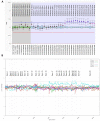Large Genomic Imbalances in Brugada Syndrome
- PMID: 27684715
- PMCID: PMC5042553
- DOI: 10.1371/journal.pone.0163514
Large Genomic Imbalances in Brugada Syndrome
Abstract
Purpose: Brugada syndrome (BrS) is a form of cardiac arrhythmia which may lead to sudden cardiac death. The recommended genetic testing (direct sequencing of SCN5A) uncovers disease-causing SNVs and/or indels in ~20% of cases. Limited information exists about the frequency of copy number variants (CNVs) in SCN5A in BrS patients, and the role of CNVs in BrS-minor genes is a completely unexplored field.
Methods: 220 BrS patients with negative genetic results were studied to detect CNVs in SCN5A. 63 cases were also screened for CNVs in BrS-minor genes. Studies were performed by Multiplex ligation-dependent probe amplification or Next-Generation Sequencing (NGS).
Results: The detection rate for CNVs in SCN5A was 0.45% (1/220). The detected imbalance consisted of a duplication from exon 15 to exon 28, and could potentially explain the BrS phenotype. No CNVs were found in BrS-minor genes.
Conclusion: CNVs in current BrS-related genes are uncommon among BrS patients. However, as these rearrangements may underlie a portion of cases and they undergo unnoticed by traditional sequencing, an appealing alternative to conventional studies in these patients could be targeted NGS, including in a single experiment the study of SNVs, indels and CNVs in all the known BrS-related genes.
Conflict of interest statement
Author RB received funding from FerrerInCode, a commercial company, for this study. Author CF-C received funding from Gendiag SL, a commercial company, for this study. There are no patents, products in development or marketed products to declare. This does not alter our adherence to all the PLOS ONE policies on sharing data and materials.
Figures


References
-
- Brugada P, Brugada J Right bundle branch block, persistent ST segment elevation and sudden cardiac death: a distinct clinical and electrocardiographic syndrome. A multicenter report. J Am Coll Cardiol. 1992; 20: 1391–1396. - PubMed
-
- Priori SG, Napolitano C, Gasparini M, Pappone C, Della Bella P, Giordano U, et al. Natural history of Brugada syndrome: insights for risk stratification and management. Circulation. 2002; 105: 1342–1347. - PubMed
LinkOut - more resources
Full Text Sources
Other Literature Sources
Miscellaneous

